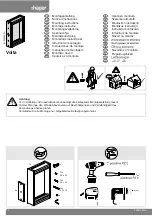
7
Operating mechanism
The operating mechanism and the
associated vacuum interrupters are identical
to those used in the standard type 38-3AH3
38 kV circuit breaker. The function and
maintenance requirements of these
elements are discussed in instruction
manual E50001-F710-A238-X-XXXX.
Ground and test device types
Separate types of the ground and test device
are available, which vary depending on
which set of studs is configured to be
grounded, and whether the test ports are
provided for one set or both sets of studs.
These are listed in Table 1: Type 38-3AH3-
GTD ground and test device types and are
described below:
l
Types D and F: Device for grounding
upper studs
A ground and test device arranged to
allow the upper primary studs to be
connected to ground has conductive
copper primary extensions in the upper
primary disconnect position. These
devices are available in two types:
l
Type D: Provided with both upper
(conductive) and lower (dummy)studs,
and with both lower and upper test
ports. The lower test port slide is
equipped with a key interlock.
Operation instructions for type D
devices are contained in the Operation -
device types B and D section of this
instruction
manual.
l
Type F: Provided with upper
(conductive) studs and with upper test
ports. Lower studs and test ports are
not provided with this device type.
Operation instructions for type F
devices are contained in the Operation -
device types E and F section of this
instruction
manual.
l
Types
B and E: Device for grounding
lower studs
A ground and test device arranged to
allow the lower primary studs to be
connected to ground has conductive
copper primary extensions in the lower
primary stud (disconnect) position.
These devices are available in two types:
l
Type B: Provided with both lower
(conductive) and upper (dummy)studs,
and with both lower and upper test
ports. The upper test port slide
is equipped with a key interlock.
Operation instructions for type B
devices are contained in the Operation -
device types B and D section of this
instruction
manual.
l
Type E: Provided with lower
(conductive) studs and with lower test
ports. Upper studs and test ports are
not provided with this device type.
Operation instructions for type F
devices are contained in the
Operation - device types E and F
section of this instruction manual.
The device type (B, D, E or F) is indicated on
the device label on front of the ground and
test device.
“Conductive studs” are designed for carrying
heavy current during grounding operations.
“Dummy studs” are for voltage test purposes
only, and are not rated to carry significant
current.
Table 1: Type 38-3AH3-GTD ground and test device types
Description
Device type
B
Device type
D
Device type
E
Device type
F
Number of studs
(disconnects)
6
6
3
3
Number of test probes
6
6
3
3
Which studs can be
grounded?
Lower
Upper
Lower
Upper
Upper studs
Dummy
Conductive
None
Conductive
Upper test ports
Yes (with key
interlock)
Yes
None
Yes
Lower studs
Conductive
Dummy
Conductive
None
Lower test ports
Yes
Yes (with key
interlock)
Yes
None
Front view figure
4
6
11
13
Side view figure
5
7
12
14
Elementary diagram
8
9
15
16








































